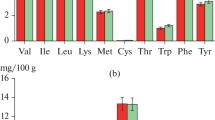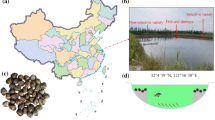Abstract
The oyster is well-known for its delicious taste and nutritional benefits. However, the taste of oysters in the market is relatively monotonous at present. In order to develop more tastes of oysters, this study explored the taste compounds (organic-acids, 5′-nucleotides and free amino acids) of Pacific oysters (Crassostrea gigas, triploid oyster) obtained from aquaculture at three different salinities (25‰, 28‰ and 32‰). The results showed that the contents of 5′-nucleotides (52.59 mg/100 g) in the test samples from the aquaculture salinity of 28‰ were higher than those in the salinity of 25‰ and 32‰. The contents of free amino acids (1760.47 mg/100 g) in the 32‰ sample were higher than those in the salinity of 25‰ and 28‰ ones. In addition, the taste activity value (TAV) and equivalent umami concentration (EUC) of three samples were calculated. The relationship between EUC and sensory evaluation was also investigated. The results showed that the highest TAV of the major free amino acids and 5′-nucleotides was observed in the 28‰ salinity oyster sample. A positive relationship was established between EUC and sensory score of overall taste as well as umami, respectively. Our results suggested that 28‰ was the optimal aquaculture salinity with regards to the oyster’s taste, and it was the most commonly accepted. The study may be helpful to guide rational development of diversified flavors of oyster.




Similar content being viewed by others
References
P. Soletchnik, O.L. Moine, P. Goulletquer, Optimisation of the traditional Pacific cupped oyster (Crassostrea gigas Thunberg) culture on the French Atlantic coastline: autumnal fattening in semi-closed ponds. Aquaculture 199, 73–91 (2001). https://doi.org/10.1016/s0044-8486(01)00554-3
V.J. Houcke, I. Medina, H.K. Maehre, J. Cornet, M. Cardinal, J. Linssen, J. Luten, The effect of algae diets (Skeletonema costatum and Rhodomonas baltica) on the biochemical composition and sensory characteristics of Pacific cupped oysters (Crassostrea gigas) during land-based refinement. Food Res. Int. 100, 151–160 (2017). https://doi.org/10.1016/j.foodres.2017.06.041
M. Yuasa, K. Kawabeta, A. Eguchi, H. Abe, E. Yamashita, K. Koba, M. Tominaga, Characterization of taste and micronutrient content of rock oysters (Crassostrea nippona) and Pacific oysters (Crassostrea gigas) in Japan. Int. J. Gastron. Food Sci. 13, 52–57 (2018). https://doi.org/10.1016/j.ijgfs.2018.06.001
K. Chen, E. Li, L. Gan, X. Wang, C. Xu, H. Lin, J.G. Qin, L. Chen, Growth and lipid metabolism of the Pacific white shrimp Litopenaeus vannamei at different salinities. J. Shellfish Res. 33, 825–832 (2014). https://doi.org/10.2983/035.033.0317
B. Pogoda, B.H. Buck, R. Saborowski, W. Hagen, Biochemical and elemental composition of the offshore-cultivated oysters Ostrea edulis and Crassostrea gigas. Aquaculture 400, 53–60 (2013). https://doi.org/10.1016/j.aquaculture.2013.02.031
Z.C. Zhang, C.H. Xue, X. Gao, Z.J. Li, Q. Wang, Monthly changes of glycogen, lipid and free amino acid of oyster. J. Ocean Univ. China. 5, 257–262 (2006). https://doi.org/10.1007/s11802-006-0011-4
K.T. Son, K.B. Shim, C.W. Lim, N.Y. Yoon, J.H. Seo, S.G. Jeong, W.Y. Jeong, Y.J. Cho, Relationship of pH, glycogen, soluble protein, and turbidity between freshness of raw oyster Crassostrea gigas. Kor. J. Fish. Aquat Sci. 47, 495–500 (2014). https://doi.org/10.5657/kfas.2014.0495
Y. Liu, C. Zhang, S. Chen, Comparison of active non-volatile taste components in the viscera and adductor muscles of oyster (Ostrea rivularis Gould). Food. Sci. Technol. Res. 19, 417–424 (2013). https://doi.org/10.3136/fstr.19.417
S. Andréfouët, S. Van Wynsberge, N. Gaertner-Mazouni, C. Menkes, A. Gilbert, G. Remoissenet, Climate variability and massive mortalities challenge giant clam conservation and management efforts in French Polynesia atollss. Biol. Conserv. 160, 190–199 (2013). https://doi.org/10.1016/j.biocon.2013.01.017
S.M. Casas, R. Lavaud, M.K. La Peyre, L.A. Comeau, R. Filgueira, J.F. La Peyre, Quantifying salinity and season effects on eastern oyster clearance and oxygen consumption rates. Mar. Biol. 165, 90 (2018). https://doi.org/10.1007/s00227-018-3351-x
M.K. La Peyre, J. Geaghan, G. Decossas, J.F.L. Peyre, Analysis of environmental factors influencing salinity patterns, oyster growth, and mortality in lower Breton Sound Estuary, Louisiana, using 20 years of data. J. Coast. Res. 319, 519–530 (2016). https://doi.org/10.2112/jcoastres-d-15-00146.1
Y.L. Dang, Z. Wang, S.Y. Xu, Methods for extracting the taste compounds from water soluble extract of Jinhua ham. Eur. Food. Res. Technol. 228, 93–102 (2008). https://doi.org/10.1007/s00217-008-0910-2
D.F. Hwang, T.Y. Chen, C.Y. Shiau, S.S. Jeng, Seasonal variations of free amino acids and nucleotide-related compounds in the muscle of cultured Taiwanese puffer Takifugu rubripes. Fish. Sci. 66, 1123–1129 (2000). https://doi.org/10.1046/j.1444-2906.2000.00178.x
E.I. Adeyeye, Amino acid composition of three species of Nigerian fish: Clarias anguillaris, Oreochromis niloticus and Cynoglossus senegalensis. Food. Chem. 113, 43–46 (2009). https://doi.org/10.1016/j.foodchem.2008.07.007
P.D. Chiang, C.T. Yen, J.L. Mau, Non-volatile taste components of various broth cubes. Food. Chem. 101, 932–937 (2007). https://doi.org/10.1016/j.foodchem.2006.02.041
A.L. Pennarun, C. Prost, J. Haure, M. Demaimay, Comparison of two microalgal diets. 2. Influence on odorant composition and organoleptic qualities of raw oysters (Crassostrea gigas). J. Agric. Food. Chem. 51, 2011–2018 (2003). https://doi.org/10.1021/jf020549c
J.L. Mau, The umami taste of edible and medicinal mushrooms. Int. J. Med. Mushrooms. 7, 113–119 (2005). https://doi.org/10.1615/IntJMedMushr.v7.i12.120
D.W. Chen, M. Zhang, Non-volatile taste active compounds in the meat of Chinese mitten crab (Eriocheir sinensis). Food. Chem. 104, 1200–1205 (2007). https://doi.org/10.1016/j.foodchem.2007.01.042
N. Rotzoll, A. Dunkel, T. Hofmann, Quantitative studies, taste reconstitution, and omission experiments on the key taste compounds in morel mushrooms (Morchella deliciosa Fr.). J. Agric. Food. Chem. 54, 2705–2711 (2006). https://doi.org/10.1021/jf053131y
C. Phat, B. Moon, C. Lee, Evaluation of umami taste in mushroom extracts by chemical analysis, sensory evaluation, and an electronic tongue system. Food Chem. 192, 1068–1077 (2016). https://doi.org/10.1016/j.foodchem.2015.07.113
S. Scharbert, T. Hofmann, Molecular definition of black tea taste by means of quantitative studies, taste reconstitution, and omission experiments. J. Agric. Food. Chem. 53, 5377–5384 (2005). https://doi.org/10.1021/jf050294d
M. Abid, S. Ali, L.K. Qi, R. Zahoor, Z. Tian, D. Jiang, J.L. Snider, T. Dai, Physiological and biochemical changes during drought and recovery periods at tillering and jointing stages in wheat (Triticum aestivum L.). Sci. Rep. 8, 4615 (2018). https://doi.org/10.1038/s41598-018-21441-7
Y. Shen, B. Fu, G. Wang, Z. Li, D. Ye, Y. Jiang, H. Ji, X. Wang, D. Yu, H. Ehsan, Proteomic and metabolomic basis for improved textural quality in crisp grass carp (Ctenopharyngodon idellus C. et V) fed with a natural dietary pro-oxidant. Food. Chem. 325, 126906 (2020). https://doi.org/10.1016/j.foodchem.2020.126906
N. Zhang, W. Wang, B. Li, Y. Liu, Non-volatile taste active compounds and umami evaluation in two aquacultured pufferfish (Takifugu obscurus and Takifugu rubripes). Food Biosci. 32, 100468 (2019). https://doi.org/10.1016/j.fbio.2019.100468
H. Jasper, A. Themistoklis, S. Markus, L. Jozef, L. Joop, Consumer preference and sensory properties of the Pacific cupped oyster (Crassostrea gigas) and the European flat oyster (Ostrea edulis). J. Aquat. Food. Prod. Technol. 25, 770–776 (2016). https://doi.org/10.1080/10498850.2014.931899
M. Cochet, M. Brown, P. Kube, N. Elliott, C. Delahunty, Understanding the impact of growing conditions on oysters: a study of their sensory and biochemical characteristics. Aquac. Res. 46, 1–10 (2013). https://doi.org/10.1111/are.12210
C. Kong, J.S. Gil, C.J. Duck, Processing and shelf-life stabilities of flavoring substances of the smoke-dried oysters. Kor. J. Fish. Aquat. Sci. 39, 85–93 (2006). https://doi.org/10.5657/kfas.2006.39.2.085
D. Dashdorj, T. Amna, I. Hwang, Influence of specific taste-active components on meat flavor as affected by intrinsic and extrinsic factors: an overview. Eur. Food. Res. Technol. 241, 157–171 (2015). https://doi.org/10.1007/s00217-015-2449-3
L. Huang, Z. Wu, X. Chen, P. Weng, X. Zhang, Characterization of flavor and volatile compounds of fermented squid using electronic nose and HPMS in combination with GC-MS. Int. J. Food. Prop. 21, 760–770 (2018). https://doi.org/10.1080/10942912.2018.1454466
P. Leksrisompong, P. Gerard, K. Lopetcharat, M. Drake, Bitter taste inhibiting agents for whey protein hydrolysate and whey protein hydrolysate beverages. J. Food. Sci. 77, S282-287 (2012). https://doi.org/10.1111/j.1750-3841.2012.02800.x
M. Tikk, K. Tikk, M.A. Tørngren, L. Meinert, M.D. Aaslyng, A.H. Karlsson, H.J. Andersen, Development of inosine monophosphate and its degradation products during aging of pork of different qualities in relation to basic taste and retronasal flavor perception of the meat. J. Agric. Food. Chem. 57, 7769–7777 (2006). https://doi.org/10.1021/jf060145a
G.C. Fletcher, H.A. Bremner, J. Olley, J.A. Statham, Umami revisited: the relationship between inosine monophosphate, hypoxanthine and smiley scales for fish flavor. Food. Rev. Int. 6, 489–503 (2009). https://doi.org/10.1080/87559129009540888
J. Yue, Y. Zhang, Y. Jin, Y. Deng, Y. Zhao, Impact of high hydrostatic pressure on non-volatile and volatile compounds of squid muscles. Food Chem. 194, 12–19 (2016). https://doi.org/10.1016/j.foodchem.2015.07.134
Q. Wang, C.H. Xue, Z.J. Li, X. Fu, J. Xu, Y. Xue, Changes in the contents of ATP and its related breakdown compounds in various tissues of oyster during frozen storage. J. Ocean Univ. China. 6, 407–412 (2007). https://doi.org/10.1007/s11802-007-0407-9
M. Cochet, M. Brown, P. Kube, N. Elliott, C. Delahunty, Understanding the impact of growing conditions on oysters: a study of their sensory and biochemical characteristics. Aquac. Res. 46, 637–646 (2015). https://doi.org/10.1111/are.12210
C. Zhong, M. Nakanishi, J.T. Geng, E. Okazaki, M.J. Cao, W.Y. Weng, K. Osako, Comparison of non-volatile taste-active components in fish sauce produced from lizardfish Saurida wanieso viscera under different conditions. Fish. Sci. 81, 581–590 (2015). https://doi.org/10.1007/s12562-015-0865-8
M. Melis, B.I. Tomassini, Taste perception of sweet, sour, salty, bitter, and umami and changes due to l-arginine supplementation, as a function of genetic ability to taste 6-n-propylthiouracil. Nutrients 9, 541 (2017). https://doi.org/10.3390/nu9060541
M. Kawai, H. Uneyama, H. Miyano, Taste-active components in foods, with concentration on umami compounds. J. Health Sci. 55, 667–673 (2009). https://doi.org/10.1248/jhs.55.667
S. Kubota, K. Itoh, N. Niizeki, Organic taste active components in the hot-water extract of yellowtail muscle. Food. Sci. Technol. Res. 8, 45–49 (2002). https://doi.org/10.3136/fstr.8.45
Y.M. Shimizu, M.M. Ando, M.S. Hirata, Multiple taste functions of the umami substances in muscle extracts of yellowtail and bastard halibut. Fish. Sci. 76, 521–528 (2010). https://doi.org/10.1007/s12562-010-0231-9
Acknowledgements
This study was supported by the National Key R&D Program of China (2018YFD0901004), Innovation Team Project of Hebei (Province) Modern Agricultural Industry Technology System (HBCT2018170207), Innovation Center Project of Hebei Agricultural Product Processing Technology (199676183H) and the modern agricultural industry technology system (CARS-49).
Author information
Authors and Affiliations
Contributions
Shijie Bi: Methodology, Data Curation, Writing-original draft. Lipin Chen: Conceptualization. Zhongkai Sun: Methodology. Yunqi Wen: Writing- review & editing. Qianqian Xue: Software. Changhu Xue: Funding Resources. Zhaojie Li: Supervision. Cheng Sun: Methodology. Zihao Wei: Methodology, Writing-review & editing. Hongying Liu: Funding Resources, Writing-review & editing.
Corresponding authors
Ethics declarations
Conflict of interest
The authors declare they have no conflict of interest.
Additional information
Publisher's Note
Springer Nature remains neutral with regard to jurisdictional claims in published maps and institutional affiliations.
Rights and permissions
About this article
Cite this article
Bi, S., Chen, L., Sun, Z. et al. Investigating influence of aquaculture seawater with different salinities on non-volatile taste-active compounds in Pacific oyster (Crassostrea gigas). Food Measure 15, 2078–2087 (2021). https://doi.org/10.1007/s11694-020-00807-4
Received:
Accepted:
Published:
Issue Date:
DOI: https://doi.org/10.1007/s11694-020-00807-4




